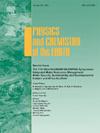用小波相干解译极端气温指数与局地尺度气象学的遥相关关系
IF 3
3区 地球科学
Q2 GEOSCIENCES, MULTIDISCIPLINARY
引用次数: 0
摘要
本文从多尺度的角度研究了极端气温指数与当地气象参数的遥相关关系。首先,对1981—2021年印度6个主要城市的9个极端温度指数(ETIs)和3个地方气象变量进行了小波分析,并利用二元小波相干性(BWTC)和多元小波相干性(MWTC)方法研究了它们之间的关联。利用德里、孟买、金奈、加尔各答、高知和古瓦哈提等气候条件、人口和地理特征明显不同的地区的相对湿度(RH)、地面气压(PS)和2米风速(WS2M)等气象变量考察了极端温度指数的变率。研究表明,所选极端温度指数与各局地气象变量之间存在显著的相干性(AWC >0.5)。相对湿度是德里和古瓦哈提最主要的当地气象变量,钦奈和高知的地面气压,孟买和加尔各答的风速。结果表明,除BWTC分析中基于百分位的TX10p和TN90p指数外,相对湿度、地面压力和风速是8-16个月尺度温度指数的重要贡献因子。多个小波相干性表明,结合两个或多个参数可以更好地解释极端事件,每个城市都有一个独特的当地气象变量组合,这些变量组合在一起最好地描述了极端气候指数的差异。本文章由计算机程序翻译,如有差异,请以英文原文为准。
Deciphering the teleconnections of extreme temperature indices with local scale meteorology using wavelet coherence
This study investigates the teleconnections of Extreme Temperature Indices (ETIs) with local meteorological parameters in a multi-scale perspective. Firstly, wavelet analysis was conducted on nine extreme temperature indices (ETIs) and three local meteorological variables over six major cities in India during the period 1981–2021, with the associations was studied using Bivariate Wavelet Coherence (BWTC) and Multivariate Wavelet Coherence (MWTC) approaches. The variability of extreme temperature indices is examined with local meteorological variables like Relative Humidity (RH), Surface Pressure (PS) and Wind speed at 2 m (WS2M) of Delhi, Mumbai, Chennai, Kolkata, Kochi and Guwahati which were distinctly different in climatic conditions, population and geographical features. The study revealed that significant coherence (AWC >0.5) exists between selected extreme temperature indices and each local meteorological variable. Relative humidity is the most dominating local meteorological variable in cities Delhi and Guwahati, surface pressure in Chennai and Kochi, and wind speed in Mumbai and Kolkata. It was observed that relative humidity, surface pressure and wind speed are significant contributors to temperature indices at a scale of 8–16 months except percentile-based indices TX10p and TN90p in BWTC analysis. Multiple wavelet coherences suggest that the extremes can be better explained by combining two or more parameters and each city each city has a unique combination of local meteorological variables that together best described variances in the extreme climate indices.
求助全文
通过发布文献求助,成功后即可免费获取论文全文。
去求助
来源期刊

Physics and Chemistry of the Earth
地学-地球科学综合
CiteScore
5.40
自引率
2.70%
发文量
176
审稿时长
31.6 weeks
期刊介绍:
Physics and Chemistry of the Earth is an international interdisciplinary journal for the rapid publication of collections of refereed communications in separate thematic issues, either stemming from scientific meetings, or, especially compiled for the occasion. There is no restriction on the length of articles published in the journal. Physics and Chemistry of the Earth incorporates the separate Parts A, B and C which existed until the end of 2001.
Please note: the Editors are unable to consider submissions that are not invited or linked to a thematic issue. Please do not submit unsolicited papers.
The journal covers the following subject areas:
-Solid Earth and Geodesy:
(geology, geochemistry, tectonophysics, seismology, volcanology, palaeomagnetism and rock magnetism, electromagnetism and potential fields, marine and environmental geosciences as well as geodesy).
-Hydrology, Oceans and Atmosphere:
(hydrology and water resources research, engineering and management, oceanography and oceanic chemistry, shelf, sea, lake and river sciences, meteorology and atmospheric sciences incl. chemistry as well as climatology and glaciology).
-Solar-Terrestrial and Planetary Science:
(solar, heliospheric and solar-planetary sciences, geology, geophysics and atmospheric sciences of planets, satellites and small bodies as well as cosmochemistry and exobiology).
 求助内容:
求助内容: 应助结果提醒方式:
应助结果提醒方式:


